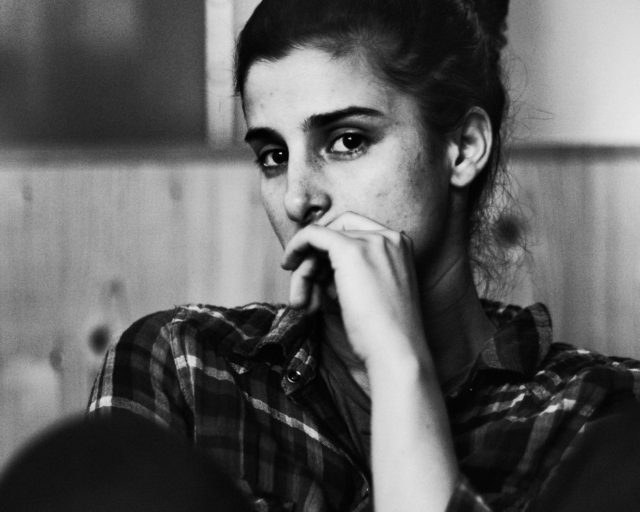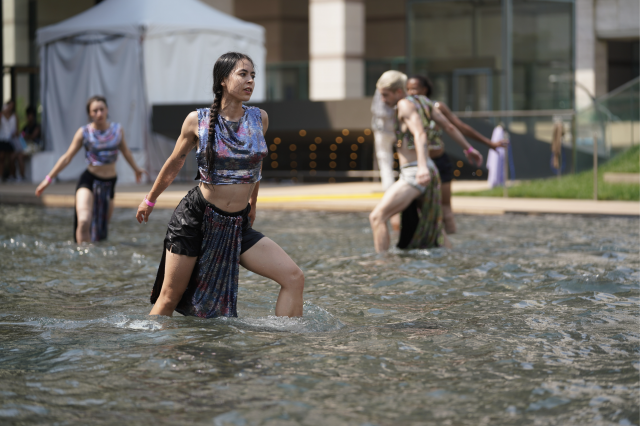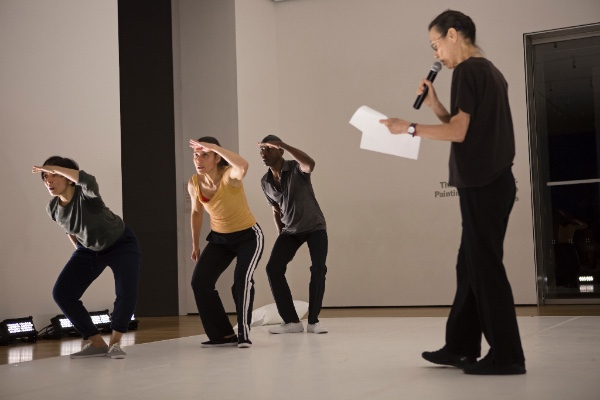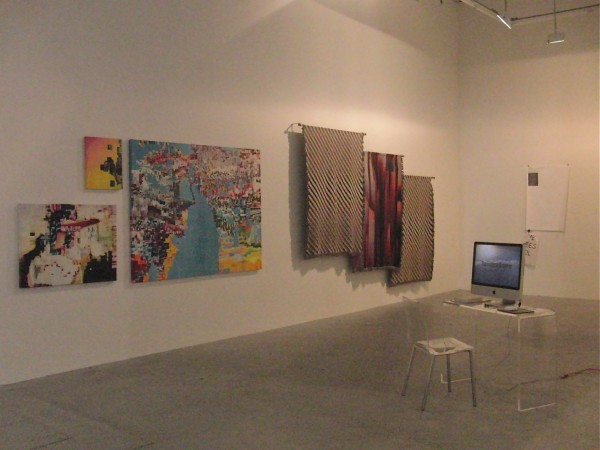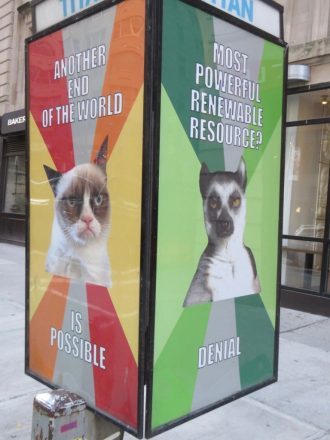
Minerva Cuevas’s “Apocalypse” and “Climate Change” are two of her three contributions to Titan phone booth project (photo by twi-ny/mdr)
TITAN
Sixth Ave. between 50th & 56th Sts.
Through January 3, free
titan.kurimanzutto.com
titan online slideshow
I’ve never owned a cell phone. For twenty-plus years, I’ve traveled around the city with quarters in my pockets in case I needed to suddenly call someone, ready to slide the change into the slot of one of the thousands of telephone booths on street corners everywhere, booths once more numerous than drugstores and coffee chains are now. However, slowly but surely, phone booths have been going the way of the dinosaur, their population shrinking not only because of the preponderance of the smart phone but also with the installation of free digital phone kiosks that also connect users to the internet. And now total extinction awaits, as the city announced in February that the more than three thousand booths that are still on the streets are being taken down, including the last four in working operation.
As a memorial to the end of another era that even Superman will lament, curators Damián Ortega and Bree Zucker, in collaboration with the Kurimanzutto gallery located on East Sixty-Fifth St. and Mexico City, have put together “Titan,” a public project spanning West Fifty-First to West Fifty-Sixth St. on Sixth Ave. in which a dozen artists have added text and/or images to the outsides of the Titan-run phone booths, where advertisements usually appear. In fact, several of the works could easily be mistaken for ads.
You have until January 3 to see the outdoor exhibition, which has a lot to say about the state of the country. Anne Collier’s 2011 “Questions” consists of photos of three open file folders that she found on the street that ask questions related to “Evidence,” “Supposition,” and “Viewpoint,” including “How do we know what we know?” Glenn Ligon’s “Aftermath” and “Synecdoche (For Byron Kim)” involve neon that are lit at specific times revolving around the November 3 election. “At the beginning of the Trump regime I began to think about whether our democracy would survive and what it means to be a citizen,” he explains in his artist statement. Meanwhile, his “Red Hands #2” is a photo of hands being raised at the 1995 Million Man March in Washington, DC. Yvonne Rainer presents “Excerpts from Apollo’s Diary, Written During His Last Visit to Earth From Mount Olympus,” in which she excoriates the current president, referring to him as “Shameless Schmuck Number One.”
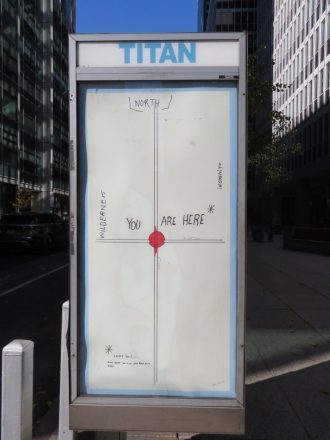
Jimmie Durham’s “You Are Here” tells us where we are literally and figuratively (photo by twi-ny/mdr)
Minerva Cuevas’s “Capitalism,” “Climate Change,” and “Apocalypse” pair photos of animals with mottos in front of angled, colorful shapes, like social media memes; for example, a picture of a grumpy cat is joined by the declaration “Another end of the world is possible.” Renee Green’s “TITAN Billboards,” from her 2015 “Space Poem #5 (Years & Afters),” is a trio of statements that, put together, read, “After You Finish Your Work,” “After the Crisis,” “Begin Again, Begin Again.” Rirkrit Tiravanija’s “Ohhh… untitled 2020 (remember in november)” comprises three text-only messages in bold fonts, advising us to “Remember in November” and to “Febreze for Fascism” as well as pointing out there are “Impostors of Patriotism.” Patti Smith tells us to “Let your peace flag fly” and that “It’s in our hands,” while Hans Haacke reminds us that “We (all) are the people” in a dozen languages, a phrase that was adopted by East Germans against the oppressive GDR but was later coopted by “right-wing, xenophobic groups in Germany with a very different meaning.”
Cildo Meireles’s “Sermon on the Mount: Fiat Lux (1974–1979)” is part of a bigger performance piece created during Brazil’s military dictatorship; here, a mirrored space features beatitudes of the Sermon on the Mount (“Blessed are those who are persecuted for righteousness’ sake, for theirs is the kingdom of heaven”). Hal Fischer’s “Handkerchiefs,” “Signifiers for a Male Response,” and “Street Fashion: Jock,” from his 1977 Gay Semiotics series, look like clothing ads but actually describe specific gay signifiers that helped identify who was gay and what kind of sex act they were interested in. “As the gay community is polarized on some issues and cohesive around others, the semiotic process which helps locate it in the larger culture will flourish with the interesting and undoubtedly provocative results,” Fischer notes. No text or artist statement accompanies Zoe Leonard’s “Crossing the Gateway International Bridge from Matamoros to Brownsville,” three photos of the border crossing between Brownsville, Texas, and Matamoros, Tamaulipas.

Anne Collier’s supplies “Evidence” as part of her “Questions” series (photo by twi-ny/mdr)
Perhaps no other work gets right to the point as does Jimmie Durham’s “You Are Here,” a spare drawing, inspired by Saul Steinberg’s classic 1976 New Yorker cover map, “How New Yorkers See the World: View of the World from 9th Avenue.” In Durham’s version, a large red circle tells visitors where they are, at the crossroads of “wilderness” and “incognito,” with an asterisk proclaiming, “Lucky you! . . . Most people had to be some place else today.” Amid a surging health crisis, during which so many of us are sheltering at home, not seeing friends, family, colleagues, or even strangers, it’s important to know where we are, both literally and figuratively, as well as who we are, as individuals and part of a whole that can make change happen, even when there are no phone booths left for Superman to save the day in our grand city.
